Epitaxial Growth of Hard Ferrimagnetic Mn3Ge Film on Rhodium Buffer Layer
Abstract
:1. Introduction
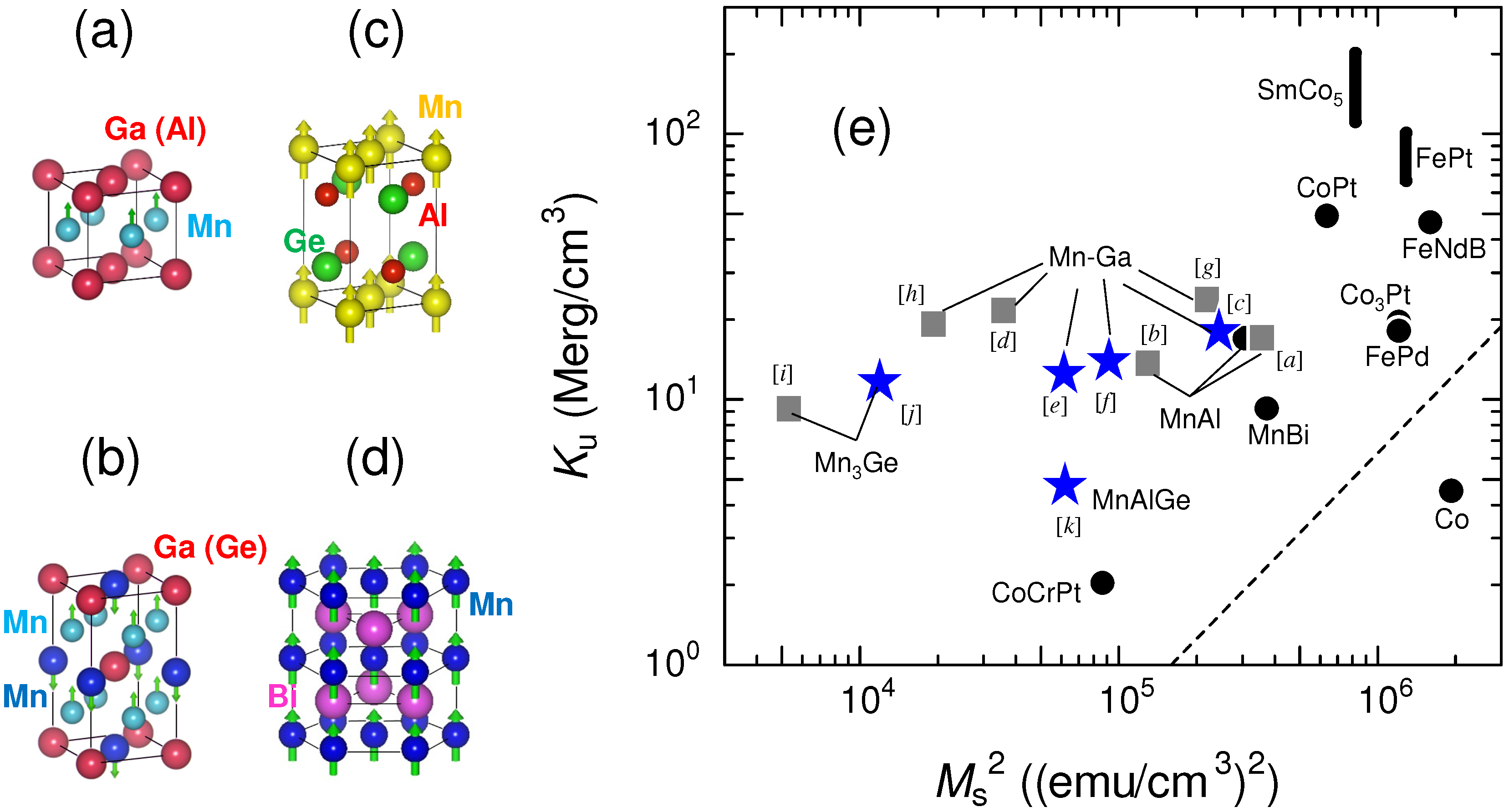
2. Experimental Methods
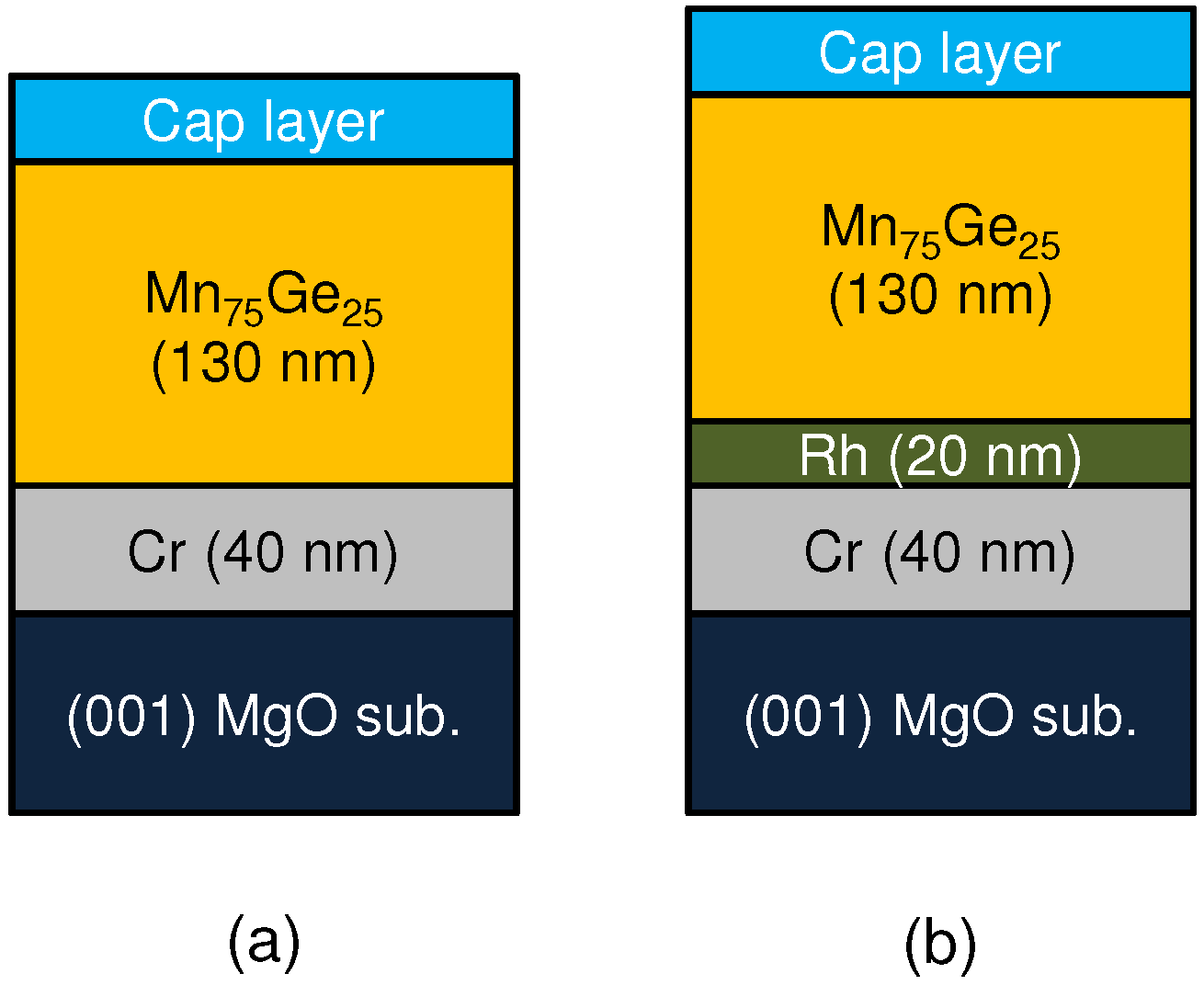
3. Experimental Results and Discussion
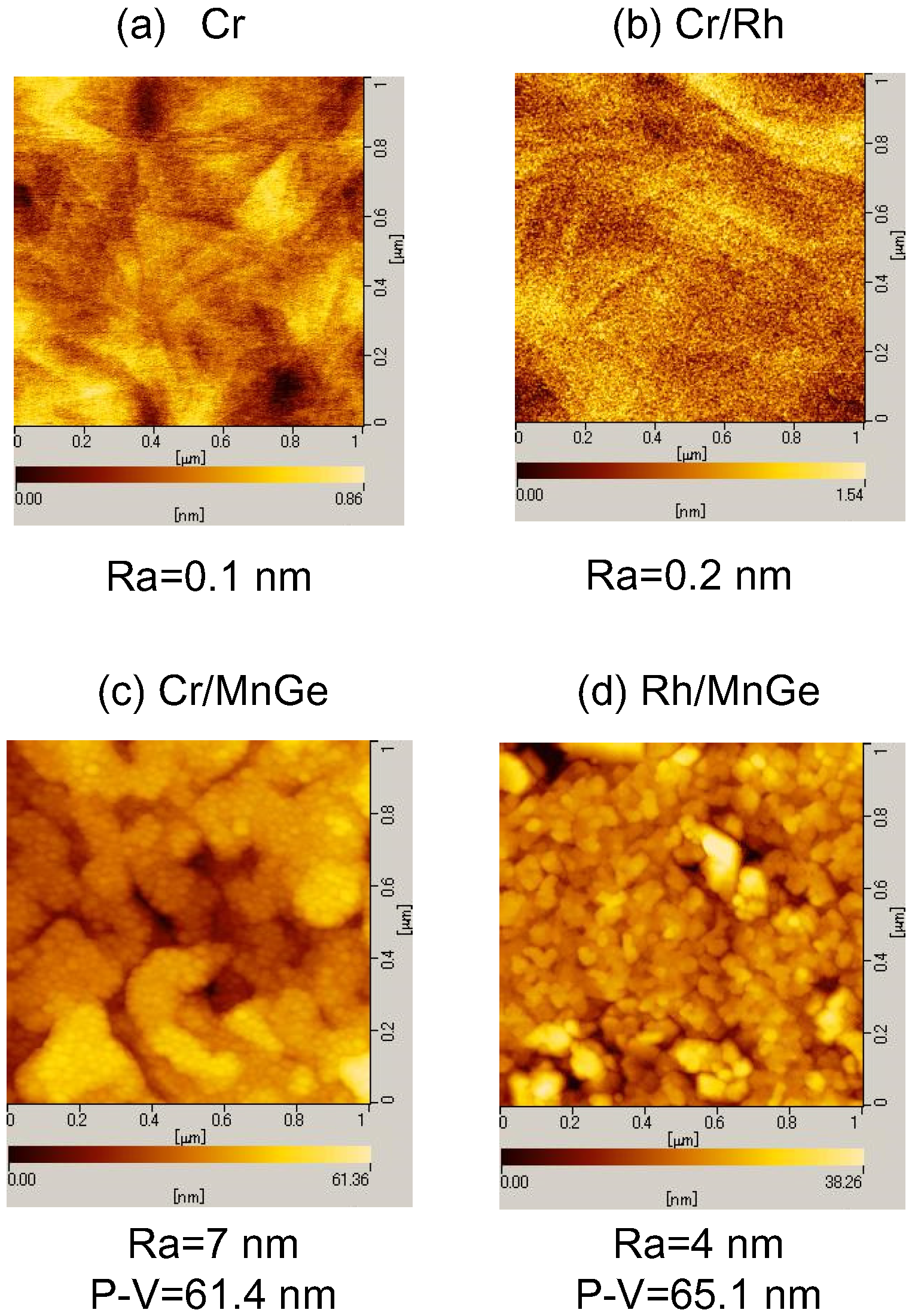
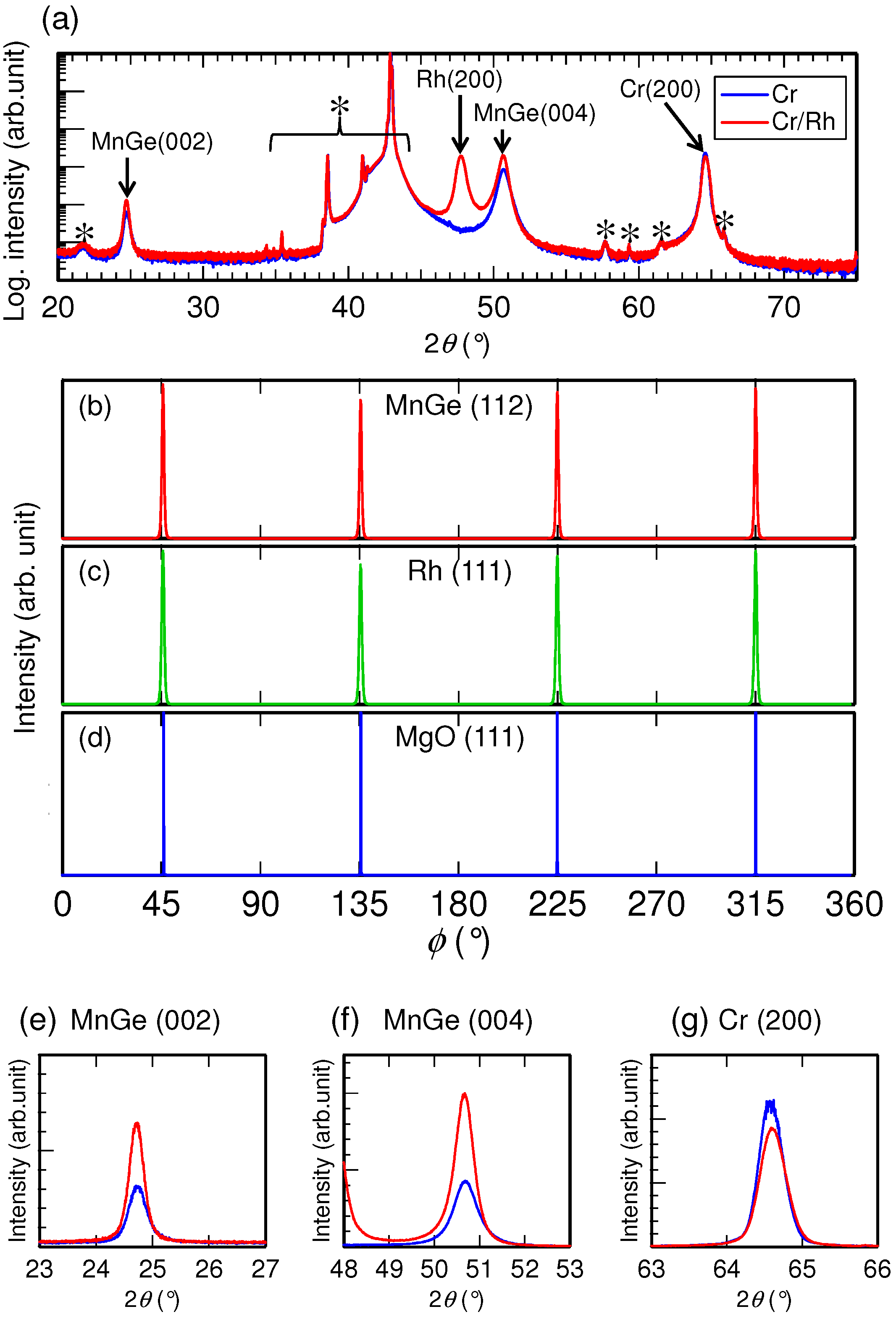
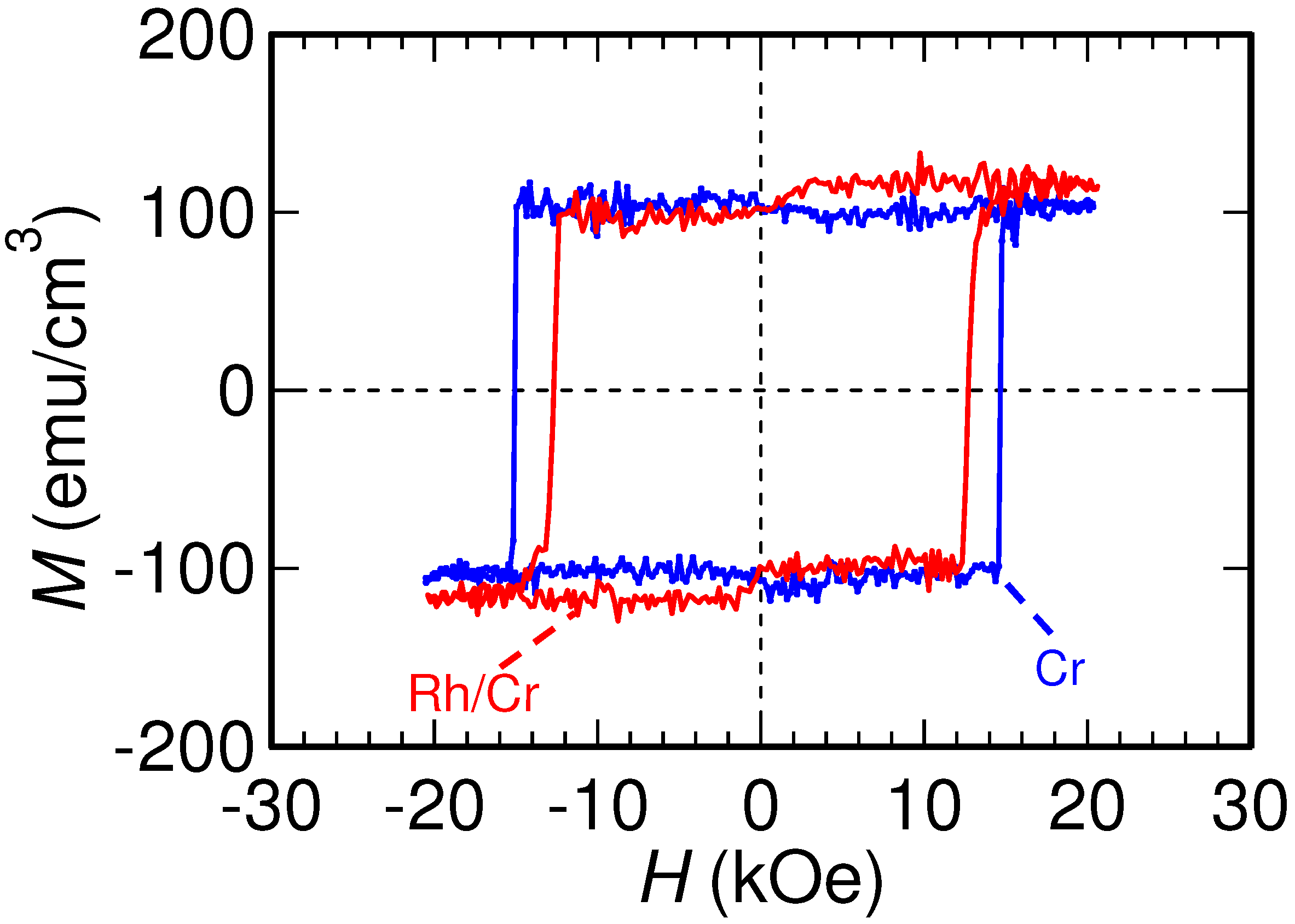
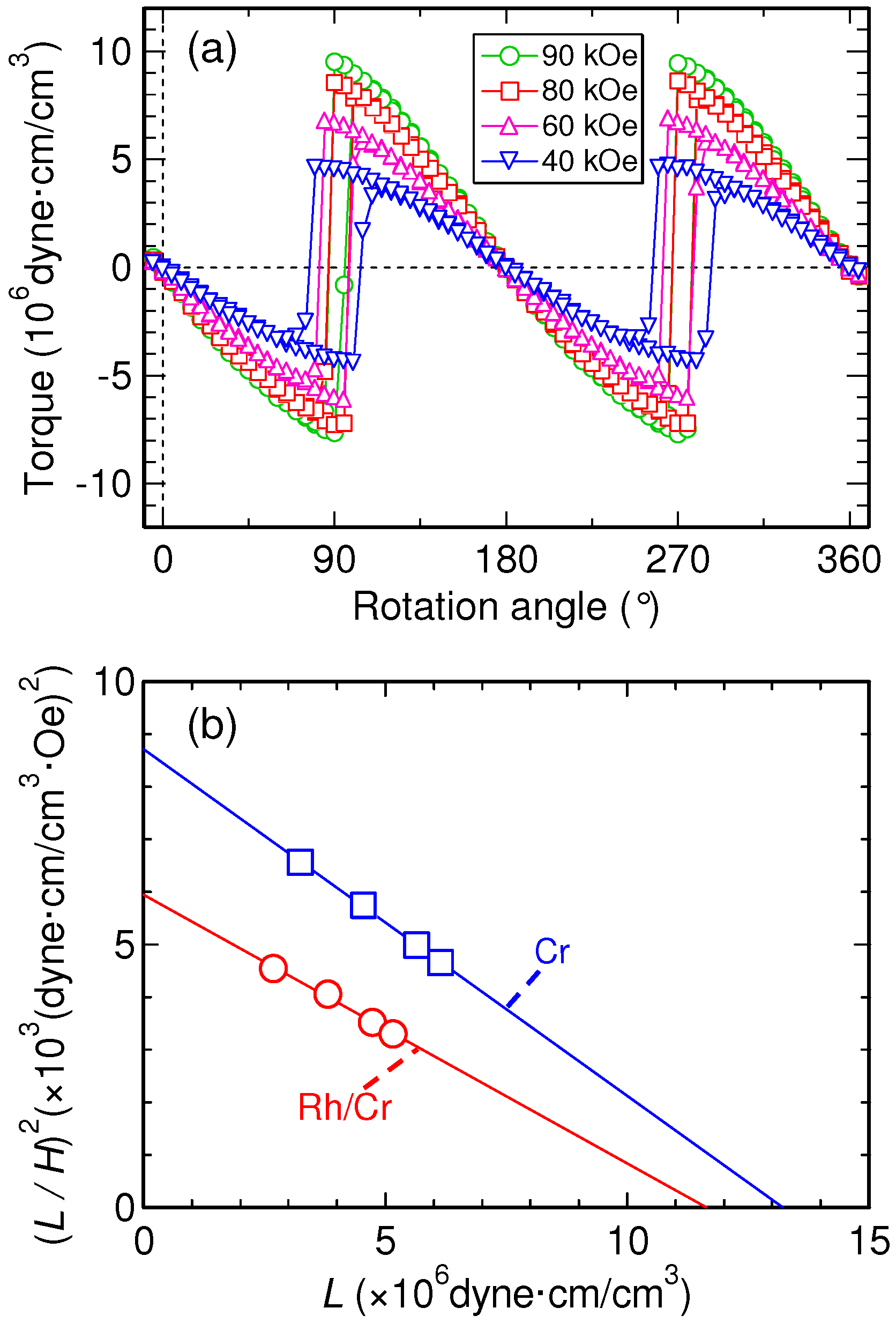
4. Conclusions
Acknowledgments
Author Contributions
Conflicts of Interest
References
- Kono, H. On the ferromagnetic phase in manganese-aluminum system. J. Phys. Soc. Jpn. 1958, 13, 1444–1451. [Google Scholar] [CrossRef]
- Koch, A.J.J.; Hokkeling, P.; de Vos, K.J. New material for permanent magnets on a base of Mn and Al. J. Appl. Phys. 1960, 31, S75–S77. [Google Scholar] [CrossRef]
- Bither, T.A.; Cloud, W.H. Magnetic tetragonal δ phase in the Mn-Ga binary. J. Appl. Phys. 1965, 36, 1501–1502. [Google Scholar] [CrossRef]
- Kr´en, E.; Ka´da´r, G. Neutron diffraction study of Mn3Ga. Solid State Commun. 1970, 8, 1653–1655. [Google Scholar] [CrossRef]
- Niida, H.; Hori, T.; Onodera, H.; Yamaguchi, Y.; Nakagawa, Y. Magnetization and coercivity of Mn3−δGa alloys with a D022-type structure. J. Appl. Phys. 1996, 79, 5946–5948. [Google Scholar] [CrossRef]
- Ohoyama, T.; Yasukochi, K.; Kanematsu, K. A new phase of an intermetallic compound Mn3.4Ge and its magnetism. J. Phys. Soc. Jpn. 1961, 16, 352–353. [Google Scholar] [CrossRef]
- Ohoyama, T. X-ray and magnetic studies of the manganese-germanium system. J. Phys. Soc. Jpn. 1961, 16, 1995–2002. [Google Scholar] [CrossRef]
- Yamada, N. Atomic magnetic moment and exchange interaction between Mn atoms in intermetallic compounds in Mn-Ge system. J. Phys. Soc. Jpn. 1990, 101, 273–288. [Google Scholar] [CrossRef]
- Wernick, J.H.; Haszko, S.E.; Romanow, W.J. New magnetic ternary compound with a high crystalline anisotropy. J. Appl. Phys. 1961, 32, 2495. [Google Scholar] [CrossRef]
- Guillaud, C. Hexagonal crystals of Mn3−δI. Ph.D. Thesis, University of Strasbourg, Strasbourg, France, 1943. [Google Scholar]
- Williams, H.J.; Sherwood, R.C.; Boothby, O.L. Magnetostriction and magnetic anisotropy of MnBi. J. Appl. Phys. 1957, 28, 445–447. [Google Scholar] [CrossRef]
- Zhu, L.; Zhao, J. Perpendicularly magnetized MnxGa films: Promising materials for future spintronic devices, magnetic recording and permanent magnets. Appl. Phys. A 2013, 111, 379–387. [Google Scholar] [CrossRef]
- Coey, J.M.D. New permanent magnets; manganese compounds. J. Phys. Condens. Matter 2014, 26, 064211-1–064211-6. [Google Scholar] [CrossRef] [PubMed]
- Weller, D.; Moser, A.; Folks, L.; Best, M.E.; Lee, W.; Toney, M.F.; Schwickert, M.; Thiele, J.-U.; Doerner, M.F. High Ku materials approach to 100 Gbits/in2. IEEE Trans. Magn. 2000, 36, 10–15. [Google Scholar] [CrossRef]
- Hosoda, M.; Oogane, M.; Kubota, M.; Kubota, T.; Saruyama, H.; Iihama, S.; Naganuma, H.; Ando, Y. Fabrication of L10-MnAl perpendicularly magnetized thin films for perpendicular magnetic tunnel junctions. J. Appl. Phys. 2012, 111, 07A324-1–07A324-3. [Google Scholar] [CrossRef]
- Nie, S.H.; Zhu, L.J.; Lu, J.; Pan, D.; Wang, H.L.; Yu, X.Z.; Xiao, J.X.; Zhao, J.H. Perpendicularly magnetized τ-MnAl (001) thin films epitaxied on GaAs. Appl. Phys. Lett. 2013, 102, 152405-1–152405-4. [Google Scholar] [CrossRef]
- Mizukami, S.; Wu, F.; Sakuma, A.; Walowski, J.; Watanabe, D.; Kubota, T.; Zhang, X.; Naganuma, H.; Oogane, M.; Ando, Y.; et al. Long-lived ultrafast spin precession in manganese alloys films with a large perpendicular magnetic anisotropy. Phys. Rev. Lett. 2011, 106, 117201-1–117201-4. [Google Scholar] [CrossRef] [PubMed]
- Zhu, L.; Nie, S.; Meng, K.; Pan, D.; Zhao, J.; Zheng, H. Multifunctional L10-Mn1.5Ga films with ultrahigh coercivity, giant perpendicular magnetocrystalline anisotropy and large magnetic energy product. Adv. Mater. 2012, 24, 4547–4551. [Google Scholar] [CrossRef] [PubMed]
- Wu, F.; Mizukami, S.; Watanabe, D.; Naganuma, H.; Oogane, M.; Ando, Y.; Miyazaki, T. Epitaxial Mn2.5Ga thin films with giant perpendicular magnetic anisotropy for spintronic devices. Appl. Phys. Lett. 2009, 94, 122503-1–122503-3. [Google Scholar] [CrossRef]
- Kurt, H.; Rode, K.; Venkatesan, M.; Stamenov, P.; Coey, J.M.D. Mn3−xGa (0 ≤ x ≤ 1): Multifunctional thin film materials for spintronics and magnetic recording. Phys. Status Solidi B 2011, 248, 2338–2344. [Google Scholar] [CrossRef]
- Kurt, H.; Baadji, N.; Rode, K.; Venkatesan, M.; Stamenov, P.; Sanvito, S.; Coey, J.M.D. Magnetic and electronic properties of D022-Mn3Ge (001) films. Appl. Phys. Lett. 2012, 101, 132410-1–132410-3. [Google Scholar] [CrossRef]
- Sugihara, A.; Mizukami, S.; Yamada, Y.; Koike, K.; Miyazaki, T. High perpendicular magnetic anisotropy in D022-Mn3+xGe tetragonal Heusler alloy films. Appl. Phys. Lett. 2014, 104, 132404-1–132404-4. [Google Scholar] [CrossRef]
- Mizukami, S.; Sakuma, A.; Kubota, T.; Kondo, Y.; Sugihara, A.; Miyazaki, T. Fast magnetization precession for perpendicularly magnetized MnAlGe epitaxial films with atomic layered structures. Appl. Phys. Lett. 2013, 103, 142405-1–142405-4. [Google Scholar] [CrossRef]
- Yoda, H.; Kishi, T.; Nagase, T.; Yoshikawa, M.; Nishiyama, K.; Kitagawa, E.; Daibou, T.; Amano, M.; Shimomura, N.; Takahashi, S.; et al. High efficient spin transfer torque writing on perpendicular magnetic tunnel junctions for high density MRAMs. Curr. Appl. Phys. 2010, 10, e87–e89. [Google Scholar] [CrossRef]
- Ma, Q.; Sugihara, A.; Suzuki, K.; Zhang, X.; Miyazaki, T.; Mizukami, S. Tetragonal Heusler-like Mn-Ga alloys based perpendicular magnetic tunnel junctions. Spin 2014, 4, 1440024-1–1440024-14. [Google Scholar] [CrossRef]
- Minakuchi, K.; Umetsu, R.Y.; Ishida, K.; Kainuma, R. Phase equilibria in the Mn-rich portion of Mn-Ga binary system. J. Alloys Compd. 2012, 537, 332–337. [Google Scholar] [CrossRef]
- Sugihara, A.; Suzuki, K.Z.; Miyazaki, T.; Mizukami, S. Structure and magnetic properties of tetragonal Heusler D022 Mn3Ge compound epitaxial films with high perpendicular magnetic anisotropy. J. Phys. D 2015, 48, 164009-1–164009-5. [Google Scholar] [CrossRef]
- Mizukami, S.; Sakuma, A.; Sugihara, A.; Kubota, T.; Kondo, Y.; Tsuchiura, H.; Miyazaki, T. Tetragonal D022 Mn3+xGe epitaxial films grown on MgO(100) with a large perpendicular magnetic anisotropy. Appl. Phys. Express 2013, 6, 123002-1–123002-4. [Google Scholar] [CrossRef]
- Miura, Y.; Shirai, M. Theoretical study on tunneling magnetoresistance of magnetic tunnel tunctions with D022-Mn3Z (Z = Ga, Ge). IEEE. Trans. Magn. 2014, 50, 1400504-1–1400504-4. [Google Scholar] [CrossRef]
- Van der Vegt, H.A.; van Pinxteren, H.M.; Lohmeier, M.; Vlieg, E. Surfactant-induced layer-by-layer growth of Ag on Ag(111). Phys. Rev. Lett. 1992, 68, 3335–3338. [Google Scholar] [CrossRef] [PubMed]
- Esch, S.; Hohage, M.; Michely, T.; Comsa, G. Origin of oxygen induced layer-by-layer growth in homoepitaxy on Pt(111). Phys. Rev. Lett. 1994, 72, 518–521. [Google Scholar] [CrossRef] [PubMed]
- Miyajima, H.; Sato, K.; Mizoguchi, T. Simple analysis of torque measurement of magnetic thin films. J. Appl. Phys. 1974, 47, 4669–4671. [Google Scholar] [CrossRef]
- Gokhale, A.B.; Abbaschian, R. The Ge-Mn (Germanium-Manganese) system. Bull. Alloy Phase Diagr. 1990, 11, 460–468. [Google Scholar] [CrossRef]
© 2015 by the authors; licensee MDPI, Basel, Switzerland. This article is an open access article distributed under the terms and conditions of the Creative Commons Attribution license (http://creativecommons.org/licenses/by/4.0/).
Share and Cite
Sugihara, A.; Suzuki, K.; Miyazaki, T.; Mizukami, S. Epitaxial Growth of Hard Ferrimagnetic Mn3Ge Film on Rhodium Buffer Layer. Metals 2015, 5, 910-919. https://doi.org/10.3390/met5020910
Sugihara A, Suzuki K, Miyazaki T, Mizukami S. Epitaxial Growth of Hard Ferrimagnetic Mn3Ge Film on Rhodium Buffer Layer. Metals. 2015; 5(2):910-919. https://doi.org/10.3390/met5020910
Chicago/Turabian StyleSugihara, Atsushi, Kazuya Suzuki, Terunobu Miyazaki, and Shigemi Mizukami. 2015. "Epitaxial Growth of Hard Ferrimagnetic Mn3Ge Film on Rhodium Buffer Layer" Metals 5, no. 2: 910-919. https://doi.org/10.3390/met5020910
APA StyleSugihara, A., Suzuki, K., Miyazaki, T., & Mizukami, S. (2015). Epitaxial Growth of Hard Ferrimagnetic Mn3Ge Film on Rhodium Buffer Layer. Metals, 5(2), 910-919. https://doi.org/10.3390/met5020910




